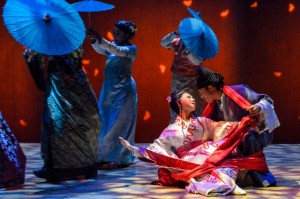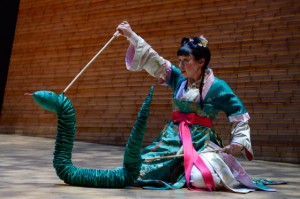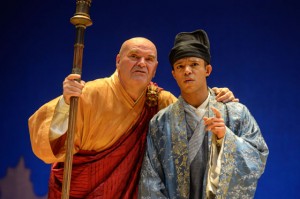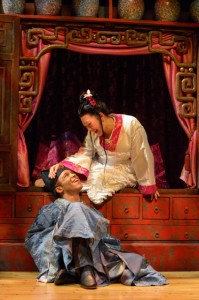A DREAMY BEDTIME STORY
Theater critics often speak of “universal themes” in the theater’”these are topics to which people in any place and at any time can relate. One of the main reasons that Greek literature, Aesop’s Fables, Shakespeare, and Grimm’s Fairy Tales, to name a few, retain their appeal is that people from varied backgrounds and beliefs can relate to the joy and sorrow of the human condition in these stories. No doubt director/writer Mary Zimmerman has always been attracted to epic tales because of their universal themes, adapting them for the theater in über-inventive productions. These tales, ancient or otherwise, also express conceptions of right and wrong behavior (“morals” for those who have forgotten they exist). While Zimmerman has created shows based on inspirational figures (Galileo Galilei, Leonardo da Vinci), she is best-known for her trademark cheeky and humorous twists on the classic works The Arabian Nights, The Odyssey, and especially Metamorphoses, which won Zimmerman a 2002 Tony Award and is currently receiving a breathtaking revival at Lookingglass in Chicago (of which Zimmerman is a member).
 Now, in a co-production with Oregon Shakespeare Festival, Zimmerman brings her sparkling theatrical inventiveness to Berkeley Rep with The White Snake, a romance adapted from an ancient Chinese legend. A shape-shifting White Snake spirit (Amy Kim Waschke) falls in love with an amiable man named Xu Xian (Christopher Livingston). With the aid of her attendant, the equally shape-shifting Green Snake’”aka Greenie (Tanya Thai McBride)’”the White Snake becomes Lady White, marries, becomes domesticated, and helps Xian set up an apothecary business. But Buddhist monk Fa Hai (Jack Willis) objects to this union of human and spirit, and although he claims altruistic motivations, he becomes the antagonist as he plots to destroy this unearthly merger.
Now, in a co-production with Oregon Shakespeare Festival, Zimmerman brings her sparkling theatrical inventiveness to Berkeley Rep with The White Snake, a romance adapted from an ancient Chinese legend. A shape-shifting White Snake spirit (Amy Kim Waschke) falls in love with an amiable man named Xu Xian (Christopher Livingston). With the aid of her attendant, the equally shape-shifting Green Snake’”aka Greenie (Tanya Thai McBride)’”the White Snake becomes Lady White, marries, becomes domesticated, and helps Xian set up an apothecary business. But Buddhist monk Fa Hai (Jack Willis) objects to this union of human and spirit, and although he claims altruistic motivations, he becomes the antagonist as he plots to destroy this unearthly merger.
The legend of the White Snake is as much a shape-shifter as the titular character. From a 981 CE folktale anthology to a 1624 story to a 1738 play, characters have been added and dropped, changing their nature along the way (in one version The White Snake belonged to a class of succubae who would butcher a man and devour his innards). All the versions have incorporated the mythic female and the mortal man, and emphasized one’s role in society’”versus the struggle for individualism inherent in western legends and fairy tales.
 Zimmerman is going for fairy tale here: A heroine desires more out of life; a wish is made; sacrifices are made to obtain it; a wish is granted; and now a price must be paid. Like a mermaid who falls for a landlubbing Prince, the White Snake is enamored with a man, but just happens to be a doting enlightened spirit with an occasional tail sticking out of her backside. The man, whose life has been a day-to-day drudgery, now springs to life, but ultimately chooses to ignore the deep-seated doubts he has sensed from the start (men ignoring their instinct’”another reason that these tales are universal).
Zimmerman is going for fairy tale here: A heroine desires more out of life; a wish is made; sacrifices are made to obtain it; a wish is granted; and now a price must be paid. Like a mermaid who falls for a landlubbing Prince, the White Snake is enamored with a man, but just happens to be a doting enlightened spirit with an occasional tail sticking out of her backside. The man, whose life has been a day-to-day drudgery, now springs to life, but ultimately chooses to ignore the deep-seated doubts he has sensed from the start (men ignoring their instinct’”another reason that these tales are universal).
The context for this production is similar to that of Paul Sills and his Story Theatre: Sills adapted fairy tales, incorporating actors as narrators, music to heighten emotion, and minimal design as a way to spur the audience’s imagination (coincidentally, this type of theater emerged from the improv work and theater games of Viola Spolin, Sills’ mother; Sills would also become founder of Second City in Chicago, the city which is the home base and proving ground of Mary Zimmerman).
 The design elements are as magical and inventive as ever for Zimmerman’s faithful design team which has worked with her for years. Daniel Ostling’s sparse set allows for the intricate details in both the lighting (T.J. Gerckens) and the traditional Chinese costumes (Mara Blumenfeld’s gorgeous combination of saturated colors and varied textiles is staggering). Shawn Sagady, a newcomer to the Zimmerman model, gets to show off his projection design skills upstage with everything from falling leaves to shifting weather patterns. Andre Pluess wrote the achingly beautiful original music, reminiscent of traditional Chinese instrumentation; the players are Tessa Brinckman (Flutes), Ronnie Malley (Strings/Percussion), and Michal Palzewicz (Cello). When a series of twirling and undulating white umbrellas bring a giant snake to life, the moment exemplifies Zimmerman’s innovation and inspiration, which is evident in totality. The design is nothing less than lovely.
The design elements are as magical and inventive as ever for Zimmerman’s faithful design team which has worked with her for years. Daniel Ostling’s sparse set allows for the intricate details in both the lighting (T.J. Gerckens) and the traditional Chinese costumes (Mara Blumenfeld’s gorgeous combination of saturated colors and varied textiles is staggering). Shawn Sagady, a newcomer to the Zimmerman model, gets to show off his projection design skills upstage with everything from falling leaves to shifting weather patterns. Andre Pluess wrote the achingly beautiful original music, reminiscent of traditional Chinese instrumentation; the players are Tessa Brinckman (Flutes), Ronnie Malley (Strings/Percussion), and Michal Palzewicz (Cello). When a series of twirling and undulating white umbrellas bring a giant snake to life, the moment exemplifies Zimmerman’s innovation and inspiration, which is evident in totality. The design is nothing less than lovely.
 Indeed, no more or less can be said about the production as a whole. I can’t call it exciting, mostly because Zimmerman’s script lacks a spark; it’s rather straightforward, lacking both momentum and truly funny moments. And besides the trio of conflict (White Lady, Xian, and Hai) and the comic relief (Greenie), undefined characters come and go: Xian’s sister and brother-in-law (Lisa Tejero and Cristofer Jean), an Acolyte, and a Crane are among the smaller roles that populate the story, but there is little character definition. The Chinese folktale archetypes are interesting, but need richer dialogue to truly spring to life. Although the script is short of compelling, the story, which takes up 100 minutes, manages to hold our interest, wrapped up as it is in such sheer loveliness, and we are definitely curious to see how it all ends. Imagine if you were a child lying safe in your bed, and your parent is reading a bedtime story with the aid of a gorgeous pop-up book and lush music: No matter how beautiful, the overall effect is still somewhat lulling.
Indeed, no more or less can be said about the production as a whole. I can’t call it exciting, mostly because Zimmerman’s script lacks a spark; it’s rather straightforward, lacking both momentum and truly funny moments. And besides the trio of conflict (White Lady, Xian, and Hai) and the comic relief (Greenie), undefined characters come and go: Xian’s sister and brother-in-law (Lisa Tejero and Cristofer Jean), an Acolyte, and a Crane are among the smaller roles that populate the story, but there is little character definition. The Chinese folktale archetypes are interesting, but need richer dialogue to truly spring to life. Although the script is short of compelling, the story, which takes up 100 minutes, manages to hold our interest, wrapped up as it is in such sheer loveliness, and we are definitely curious to see how it all ends. Imagine if you were a child lying safe in your bed, and your parent is reading a bedtime story with the aid of a gorgeous pop-up book and lush music: No matter how beautiful, the overall effect is still somewhat lulling.
 Yet even without a powerhouse script, the story, the dazzling visuals and the distinctive ensemble make this a worthwhile trip (the ensemble, some of whom act as narrators and interpreters of the Lady White’s journey, are Keiko Shimosato Carreiro, Gina Daniels, Richard Howard, Emily Sophia Knapp, and Vin Kridakorn).
Yet even without a powerhouse script, the story, the dazzling visuals and the distinctive ensemble make this a worthwhile trip (the ensemble, some of whom act as narrators and interpreters of the Lady White’s journey, are Keiko Shimosato Carreiro, Gina Daniels, Richard Howard, Emily Sophia Knapp, and Vin Kridakorn).
But there’s one thing more. Regardless of how one may feel about the overall proceedings (the show is so damn lovely that it’s almost critic-proof), Zimmerman adds an immensely satisfying coda to her piece that will resonate with you long after exiting the theater; it comes out of nowhere, but elegantly caps the story with a wrap-up of universal themes. We see what we have in common with the mythic snake who desires more and the unfulfilled, doubting man who has trouble finding happiness outside of his partner. As in that bedtime story, lessons are reinforced; and like the child who hears it, we are comforted.
photos by Alessandra Mello, courtesy of mellopix.com
The White Snake
a co-production with Oregon Shakespeare Festival at Berkeley Rep
though December 23, 2012 EXTENDED through December 30, 2012
for tickets, call (510) 647-2949 or visit http://www.berkeleyrep.org

